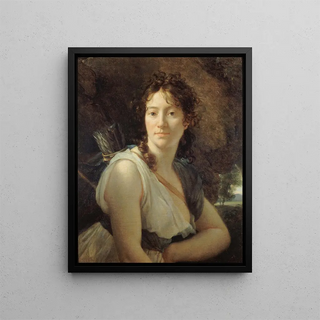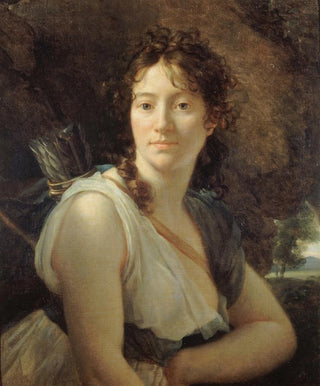Portrait painting of Mademoiselle Duchesnois 1777-1835, member of the French Comedy in the role of Dido - François Gérard


View from behind

Frame (optional)
Portrait of Mademoiselle Duchesnois 1777-1835, Member of the French Comedy, in the role of Dido - François Gérard – Captivating introduction
In the fascinating world of art, some works transcend time and capture the very essence of their era. The portrait of Mademoiselle Duchesnois, painted by François Gérard, is one of these iconic pieces. Created in the early 19th century, this artwork not only depicts a famous actress from the French Comedy but also embodies the aspirations and passions of a period in full transformation. By highlighting the figure of this talented performer in the role of Dido, Gérard offers a window into the theatrical world of his time, while exploring universal themes such as beauty, drama, and the portrayal of femininity.
Style and uniqueness of the work
François Gérard's style is distinguished by its elegance and ability to blend classicism with new romantic trends. In this portrait, the delicacy of Mademoiselle Duchesnois's features is emphasized through a palette of soft colors and subtle lighting that creates an intimate atmosphere. The choice of pose, both noble and accessible, demonstrates technical mastery that allows the viewer to feel a deep connection with the subject. Gérard uses meticulous details, such as the drapery of the dress and the expression on her face, to convey the actress's personality while giving her an almost mythological aura. This artwork is not limited to a simple representation; it evokes a story, that of a strong woman who was influential on the theatrical stage, while paying tribute to the timeless beauty of art.
The artist and his influence
François Gérard, one of the most prominent portraitists of his time, knew how to establish himself through his talent and keen sense of observation. Trained at the Academy of Painting, he evolved with his era, drawing inspiration from masters while developing his own style. His work reflects the aesthetic and social concerns of the late 18th and early 19th centuries, a period marked by political and cultural upheavals. By painting iconic figures

Matte finish

View from behind

Frame (optional)
Portrait of Mademoiselle Duchesnois 1777-1835, Member of the French Comedy, in the role of Dido - François Gérard – Captivating introduction
In the fascinating world of art, some works transcend time and capture the very essence of their era. The portrait of Mademoiselle Duchesnois, painted by François Gérard, is one of these iconic pieces. Created in the early 19th century, this artwork not only depicts a famous actress from the French Comedy but also embodies the aspirations and passions of a period in full transformation. By highlighting the figure of this talented performer in the role of Dido, Gérard offers a window into the theatrical world of his time, while exploring universal themes such as beauty, drama, and the portrayal of femininity.
Style and uniqueness of the work
François Gérard's style is distinguished by its elegance and ability to blend classicism with new romantic trends. In this portrait, the delicacy of Mademoiselle Duchesnois's features is emphasized through a palette of soft colors and subtle lighting that creates an intimate atmosphere. The choice of pose, both noble and accessible, demonstrates technical mastery that allows the viewer to feel a deep connection with the subject. Gérard uses meticulous details, such as the drapery of the dress and the expression on her face, to convey the actress's personality while giving her an almost mythological aura. This artwork is not limited to a simple representation; it evokes a story, that of a strong woman who was influential on the theatrical stage, while paying tribute to the timeless beauty of art.
The artist and his influence
François Gérard, one of the most prominent portraitists of his time, knew how to establish himself through his talent and keen sense of observation. Trained at the Academy of Painting, he evolved with his era, drawing inspiration from masters while developing his own style. His work reflects the aesthetic and social concerns of the late 18th and early 19th centuries, a period marked by political and cultural upheavals. By painting iconic figures
12,34 €






